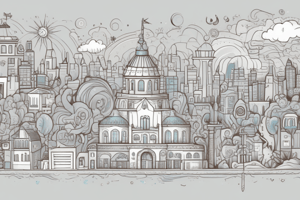Podcast
Questions and Answers
What are the three elements of the L-F-S Framework of leadership?
What are the three elements of the L-F-S Framework of leadership?
Leader, Follower, and Context/Situation
What are the two leader behaviors identified in the behavioral approach to leadership?
What are the two leader behaviors identified in the behavioral approach to leadership?
Initiating Structure and Consideration
What is the primary goal of Transformational Leadership?
What is the primary goal of Transformational Leadership?
Changing and transforming people by assessing followers' motives, satisfying their needs, and treating them as full human beings.
What is the key difference between In-Group and Out-Group relationships in the Leader Member Exchange (LMX) Theory?
What is the key difference between In-Group and Out-Group relationships in the Leader Member Exchange (LMX) Theory?
What is the focus of the Role-based approach to leadership?
What is the focus of the Role-based approach to leadership?
What is the primary focus of the Constructionist approach to leadership?
What is the primary focus of the Constructionist approach to leadership?
What is the definition of Organizational Culture?
What is the definition of Organizational Culture?
What is the key characteristic of Pseudo-Transformational Leadership?
What is the key characteristic of Pseudo-Transformational Leadership?
What are the five core elements of the well-being theory, also known as PERMA?
What are the five core elements of the well-being theory, also known as PERMA?
What are the four components of Psychological Capital, also known as HERO?
What are the four components of Psychological Capital, also known as HERO?
What are the three characteristics of effective team players?
What are the three characteristics of effective team players?
What are the four factors that affect media richness in communication?
What are the four factors that affect media richness in communication?
What is the difference between functional and dysfunctional conflict?
What is the difference between functional and dysfunctional conflict?
What are the five types of influence tactics, categorized as SOFT and HARD?
What are the five types of influence tactics, categorized as SOFT and HARD?
What is organizational politics, and how does it affect outcomes?
What is organizational politics, and how does it affect outcomes?
What is the relationship between team cohesion and cooperation and trust?
What is the relationship between team cohesion and cooperation and trust?
What are the benefits of social media usage in the workplace?
What are the benefits of social media usage in the workplace?
What is the difference between personality conflict and team/interpersonal conflict?
What is the difference between personality conflict and team/interpersonal conflict?
How does the Initiating Structure behavioral approach of a leader impact the followers' roles and responsibilities?
How does the Initiating Structure behavioral approach of a leader impact the followers' roles and responsibilities?
What are the implications of a leader's Consideration behavior on the overall work environment and employee motivation?
What are the implications of a leader's Consideration behavior on the overall work environment and employee motivation?
How does the Transformational Leadership approach differ from the Pseudo-Transformational Leadership approach in terms of its impact on followers?
How does the Transformational Leadership approach differ from the Pseudo-Transformational Leadership approach in terms of its impact on followers?
What are the key differences between the In-Group and Out-Group relationships in the Leader Member Exchange (LMX) Theory?
What are the key differences between the In-Group and Out-Group relationships in the Leader Member Exchange (LMX) Theory?
How does the Role-based approach to leadership differ from the Constructionist approach in terms of its focus and outcomes?
How does the Role-based approach to leadership differ from the Constructionist approach in terms of its focus and outcomes?
What are the key components of an organization's culture, and how do they impact employee behavior and outcomes?
What are the key components of an organization's culture, and how do they impact employee behavior and outcomes?
How does a leader's Initiating Structure behavior impact the overall performance and productivity of a team?
How does a leader's Initiating Structure behavior impact the overall performance and productivity of a team?
What are the implications of a leader's Transformational Leadership approach on the overall motivation and engagement of followers?
What are the implications of a leader's Transformational Leadership approach on the overall motivation and engagement of followers?
How does the Leader Member Exchange (LMX) Theory explain the impact of leader-follower relationships on work-related outcomes?
How does the Leader Member Exchange (LMX) Theory explain the impact of leader-follower relationships on work-related outcomes?
What are the key differences between the behavioral approach and the Constructionist approach to leadership in terms of their focus and outcomes?
What are the key differences between the behavioral approach and the Constructionist approach to leadership in terms of their focus and outcomes?
What are the key differences between a group and a team, and how do they relate to organizational tasks?
What are the key differences between a group and a team, and how do they relate to organizational tasks?
How does the well-being theory, also known as PERMA, contribute to positive organizational behavior?
How does the well-being theory, also known as PERMA, contribute to positive organizational behavior?
What are the benefits of using social media in the workplace, and how can it impact employee job satisfaction and collaboration?
What are the benefits of using social media in the workplace, and how can it impact employee job satisfaction and collaboration?
How does the concept of media richness affect communication in the digital age, and what are the implications for effective communication?
How does the concept of media richness affect communication in the digital age, and what are the implications for effective communication?
What are the differences between functional and dysfunctional conflict, and how can they impact organizational outcomes?
What are the differences between functional and dysfunctional conflict, and how can they impact organizational outcomes?
How does the concept of psychological capital, also known as HERO, contribute to positive organizational behavior?
How does the concept of psychological capital, also known as HERO, contribute to positive organizational behavior?
What are the key characteristics of effective team players, and how do they contribute to team cohesion and cooperation?
What are the key characteristics of effective team players, and how do they contribute to team cohesion and cooperation?
How does the concept of team cohesion impact cooperation and trust among team members, and what are the implications for organizational performance?
How does the concept of team cohesion impact cooperation and trust among team members, and what are the implications for organizational performance?
What are the differences between personality conflict and team/interpersonal conflict, and how can they impact organizational outcomes?
What are the differences between personality conflict and team/interpersonal conflict, and how can they impact organizational outcomes?
How does the concept of influence tactics, categorized as SOFT and HARD, impact organizational politics and outcomes?
How does the concept of influence tactics, categorized as SOFT and HARD, impact organizational politics and outcomes?
Study Notes
Positive Organizational Behavior (6.2)
- Well-being theory is based on five positive personal attributes, known as PERMA.
- PERMA consists of:
- Positive emotion (experiencing pleasure)
- Engagement (psychological state of flow or enjoying activities)
- Relationships (creating and maintaining positive relationships)
- Meaning (finding a strong purpose in life)
- Accomplishment (achieving positive outcomes and mastering new skills)
Main POB-Related Framework (2)
- Psychological Capital is a positive and developmental state of an individual, which can be utilized as a competitive resource.
- Psychological Capital is represented by the HERO framework, which consists of:
- Hope (persevering toward goals and redirecting paths when necessary)
- Efficacy (having confidence to take on challenging tasks)
- Resilience (sustaining and bouncing back from stress, conflict, and failure)
- Optimism (making a positive attribution about succeeding)
Groups and Teams (7.2)
- A group becomes a team when they develop a sense of shared commitment and strive for synergy among members to perform specific organizational tasks.
- Differentiating between groups and teams:
- Group: A collection of individuals who share certain characteristics
- Team: A group of individuals who share a common goal and work together to achieve it
- Team cohesion is the degree to which members feel part of the collective or "WE" of the team, which is developed through cooperation and trust.
- Effective team players have three characteristics:
- Committed (to the team with a sense of "WE-ness")
- Collaborative (rather than competitive)
- Competent (and build reciprocal trust among team members)
Roles in Team
- A group/team role is a set of shared expected behaviors for members of the group as a whole.
Communication in the Digital Age (9.1)
- Media richness is the capacity of a given communication medium to convey information and promote understanding.
- Four factors that affect media richness:
- Speed of feedback
- Channel
- Type
- Language source
- Effective communication is achieved when media richness is matched with the complexity of the situation.
- Benefits of social media usage at the workplace:
- Connect in real-time over distance and expand boundaries
- Increase job satisfaction and better work-life balance
- More collaboration and creativity
- Costs of social media usage at the workplace:
- Employee cyber loafing
- Using social media to find out other organizations and search for a new job
Communication in the Digital Age (9.2)
- (No additional notes)
Managing Conflict and Negotiations (10.1)
- Personality conflict is interpersonal opposition based on personal dislike or disagreement.
- Team/interpersonal conflict is the process resulting from the tension between team members due to real or perceived differences.
- Dysfunctional conflict:
- Threatens organization's interests
- Typically "person-focused"
- Breeds hostility
- Disturbs communication
- Desired conflict outcomes:
- Agreement
- Stronger relationships
- Learning
- Work-life (family) conflict is the perception that expectations and demands between work and non-work roles are mutually incompatible.
- Incivility is any form of socially harmful behavior, including aggression, interpersonal deviance, social undermining, interactional injustice, and bullying.
Managing Conflict and Negotiations (10.2)
- (No additional notes)
Power, Influence, and Politics (11.1)
- Influence tactics can be categorized into SOFT and HARD tactics.
- SOFT tactics:
- Rational Persuasion
- Inspirational appeal
- Consultation
- Ingratiation
- Personal Appeal
- HARD tactics:
- Exchange
- Coalition
- Pressure
- Legitimating
- Organizational politics are intentional actions to improve self/individual- or organizational-interests.
- Perceptions of organizational politics and outcomes are individual subjective attributions of others' behaviors to self-serving intent.
Leadership Effectiveness (12.1)
- The L-F-S framework of leadership consists of three elements:
- Leader (individual differences)
- Follower (individual differences)
- Context/Situation (contextual characteristics)
- Behavioral approach in the leadership process:
- Initiating Structure (task-oriented leader behavior)
- Consideration (relationship-oriented leader behavior)
- Transformational Leadership is a leadership process focusing on changing and transforming people by assessing followers' motives, satisfying their needs, and treating them as full human beings.
- Pseudo-Transformational Leadership is a leadership process that transforms others in a negative way, with warped moral values.
- Leader Member exchange (LMX) Theory is based on the degree of exchanged relational quality between leader and follower.
- Organizational culture is the unique set of shared values and beliefs that underlie a company's identity.
Positive Organizational Behavior (6.2)
- Well-being theory is based on five positive personal attributes, known as PERMA.
- PERMA consists of:
- Positive emotion (experiencing pleasure)
- Engagement (psychological state of flow or enjoying activities)
- Relationships (creating and maintaining positive relationships)
- Meaning (finding a strong purpose in life)
- Accomplishment (achieving positive outcomes and mastering new skills)
Main POB-Related Framework (2)
- Psychological Capital is a positive and developmental state of an individual, which can be utilized as a competitive resource.
- Psychological Capital is represented by the HERO framework, which consists of:
- Hope (persevering toward goals and redirecting paths when necessary)
- Efficacy (having confidence to take on challenging tasks)
- Resilience (sustaining and bouncing back from stress, conflict, and failure)
- Optimism (making a positive attribution about succeeding)
Groups and Teams (7.2)
- A group becomes a team when they develop a sense of shared commitment and strive for synergy among members to perform specific organizational tasks.
- Differentiating between groups and teams:
- Group: A collection of individuals who share certain characteristics
- Team: A group of individuals who share a common goal and work together to achieve it
- Team cohesion is the degree to which members feel part of the collective or "WE" of the team, which is developed through cooperation and trust.
- Effective team players have three characteristics:
- Committed (to the team with a sense of "WE-ness")
- Collaborative (rather than competitive)
- Competent (and build reciprocal trust among team members)
Roles in Team
- A group/team role is a set of shared expected behaviors for members of the group as a whole.
Communication in the Digital Age (9.1)
- Media richness is the capacity of a given communication medium to convey information and promote understanding.
- Four factors that affect media richness:
- Speed of feedback
- Channel
- Type
- Language source
- Effective communication is achieved when media richness is matched with the complexity of the situation.
- Benefits of social media usage at the workplace:
- Connect in real-time over distance and expand boundaries
- Increase job satisfaction and better work-life balance
- More collaboration and creativity
- Costs of social media usage at the workplace:
- Employee cyber loafing
- Using social media to find out other organizations and search for a new job
Communication in the Digital Age (9.2)
- (No additional notes)
Managing Conflict and Negotiations (10.1)
- Personality conflict is interpersonal opposition based on personal dislike or disagreement.
- Team/interpersonal conflict is the process resulting from the tension between team members due to real or perceived differences.
- Dysfunctional conflict:
- Threatens organization's interests
- Typically "person-focused"
- Breeds hostility
- Disturbs communication
- Desired conflict outcomes:
- Agreement
- Stronger relationships
- Learning
- Work-life (family) conflict is the perception that expectations and demands between work and non-work roles are mutually incompatible.
- Incivility is any form of socially harmful behavior, including aggression, interpersonal deviance, social undermining, interactional injustice, and bullying.
Managing Conflict and Negotiations (10.2)
- (No additional notes)
Power, Influence, and Politics (11.1)
- Influence tactics can be categorized into SOFT and HARD tactics.
- SOFT tactics:
- Rational Persuasion
- Inspirational appeal
- Consultation
- Ingratiation
- Personal Appeal
- HARD tactics:
- Exchange
- Coalition
- Pressure
- Legitimating
- Organizational politics are intentional actions to improve self/individual- or organizational-interests.
- Perceptions of organizational politics and outcomes are individual subjective attributions of others' behaviors to self-serving intent.
Leadership Effectiveness (12.1)
- The L-F-S framework of leadership consists of three elements:
- Leader (individual differences)
- Follower (individual differences)
- Context/Situation (contextual characteristics)
- Behavioral approach in the leadership process:
- Initiating Structure (task-oriented leader behavior)
- Consideration (relationship-oriented leader behavior)
- Transformational Leadership is a leadership process focusing on changing and transforming people by assessing followers' motives, satisfying their needs, and treating them as full human beings.
- Pseudo-Transformational Leadership is a leadership process that transforms others in a negative way, with warped moral values.
- Leader Member exchange (LMX) Theory is based on the degree of exchanged relational quality between leader and follower.
- Organizational culture is the unique set of shared values and beliefs that underlie a company's identity.
Studying That Suits You
Use AI to generate personalized quizzes and flashcards to suit your learning preferences.
Related Documents
Description
This quiz covers the main frameworks related to Positive Organizational Behavior, including the well-being theory and PERMA. Test your knowledge of positive emotions, engagement, and relationships in the workplace.




